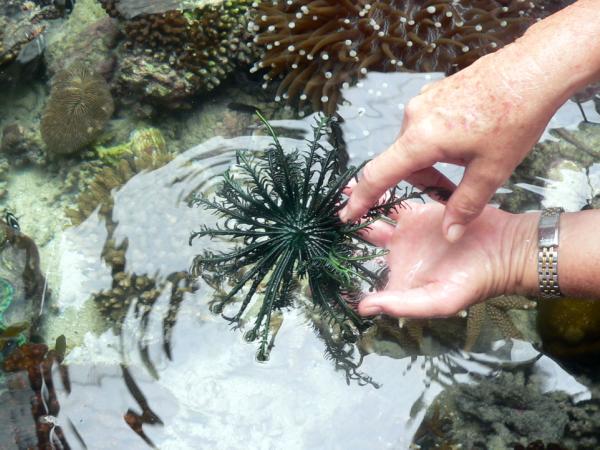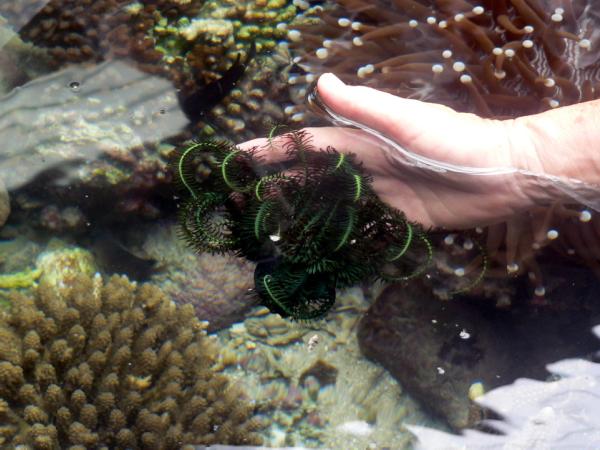Published in the Ocean Watch column, Honolulu Star-Advertiser © Susan Scott
September 28, 2007
One of the most weird and wonderful creatures I’m enjoying on Australia’s Great Barrier Reef are crinoids, also called feather stars.
These relatives of starfish and sea urchins aren’t restricted to this area, but they sure like it here.
Fifty-six species alone are found here at Lizard Island.
Feather stars look like bundles of flexible feathers from 4 to 10 inches across, and come in breathtaking colors: black with iridescent green flecks, black-and-yellow banded, iridescent green or yellow, bright orange or white. And that’s just one species. There are 55 more.
Besides being beautiful, crinoids are fun to play with. At a gentle touch, some curl up in a ball, some turn away from my hand and some grasp my finger with tiny, harmless hooks they bear along the outer edges of their arms.
All recover quickly, though, and by the time I move on, they’re back to their normal business of sifting water.


Unlike starfish and sea urchin mouths, which are on their undersides, crinoid mouths face upward. The mouth is centered in a cuplike body from which, depending on species, rise 10 to 200 flexible arms ranging from a few inches long to more than a foot long.
Short, stiff projections line both sides of each arm, with spaces between them, like a comb. Such spacing allows water currents to flow through the arms.
Tiny tube feet line each projection, but these sticky feet don’t walk. They snare passing plankton and deposit the catch into the groove running down the center of the arm. Microscopic hairs then transport the food down the arm and into the mouth.
From beneath the crinoid’s cup-body poke several stubby, grasping leglike structures. These function either as little legs, moving the creature from place to place, or as holdfasts. Crinoid “legs” can grip almost anything — rocks, coral heads, sea fans, giant clams, human fingers. In some species, hooks at the tips of their arms also help the animal hang on.
Crinoids need such good anchoring mechanisms because they perch where the food is: in currents. The 6- to 8-foot tidal range here provides nearly continual currents and, therefore, gardens of colorful crinoids.
If they lose their grip, these animals can swim, sort of, by waving their feathery arms up and down in rhythm.
Once it finds a good spot and is securely attached, the crinoid opens its arms wide. Some species sit sideways to the current, and others face it like a catcher’s mitt.
Many crinoids feed around the clock, but some open only at night. During the day these species either roll up their arms and rest where they are or tuck into a crack. Crinoids don’t hide well, though, because they usually leave an arm or two sticking out to snare morsels of food passing their way.
Several kinds of reef animals take advantage of the crinoid’s shield shape, and the crinoids don’t seem to mind. A species of clingfish, lobster, shrimp and brittle star, all minuscule, routinely take shelter inside the protective arms of crinoids.
While snorkeling here, I can’t bear to swim past a feather star perched on a coral head without pausing to admire it. I don’t get far in my swims sometimes, but I don’t care. I consider crinoid appreciation the marine version of stopping to smell the flowers.
Note: you can see some excellent crinoid pictures at this website: Crinoids.